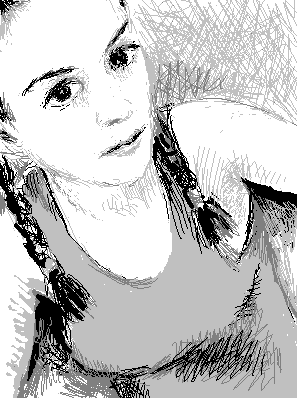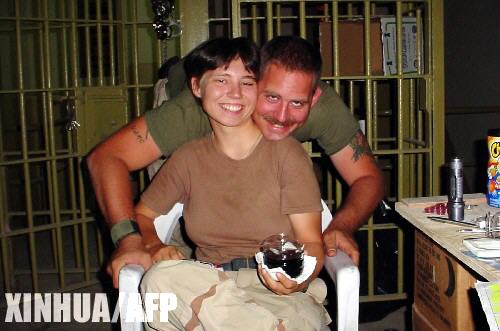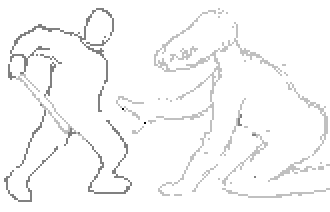View current page
...more recent posts

Camgirl (recently retired).
Artnet has a great interview up with artist Sue de Beer. Part of it is excerpted below. I've written about her work here and here and am impressed by her smarts, as well as her courage in injecting schlocko, gross-out horror conventions into the by-now familiar vocabulary of art world transgressions. It's not the shock value that makes her work special (we had Chris Burden and Karen Finley for that), or the "low culture into high," but rather some combination of the two: a willingness to be scary and as declasse as a Wes Craven movie at the mall. After the excerpt, I have a few thoughts on the relationship of her work to recent, real life (mediated) horror.
Ana Finel Honigman: Do you think deconstructing horror, like explaining a joke, kills its impact?All this talk of stabbing and guts hanging out and our relationship to it isn't just relevant to the art world. I'm curious to know what de Beer thinks of the Nick Berg "beheading" video, which is riddled with discrepancies and seems to be some hillbilly's idea of a slasher movie. Art trumping life trumping art. (I mean, check out the plastic prison chairs in the photos below.) Even though it's in a macho, war context, it made me think of Heidi 2's "operating scene," here Heidi's mom teaches Heidi how to "self operate" and Heidi removes her own stomach. This collaborative project with Laura Parnes is the exception to de Beer's credo of "either you have victims with no killer, or a killer with no victims." Unless you read the stomach operation as a self-inflicted wound (i.e., the Heidis are one person) and not as one generation literally damaging the next. At any rate, there's theatrical slashing with no spraying blood, just like the Berg video; a body part is removed and shot close-up; no dubbed-in scream, though. Anyway, apologies to Sue and Laura for comparing their work to real life melodrama; current events are forcing us to think this way.Sue de Beer: For me, if you stab something really hard with a knife, and make it bleed, you know, for art or for whatever, that should have enough impact on whoever is watching in whatever context. If it doesn’t have an impact, then it is probably just crappy.
AFH: How aggressive should art be in order to have an impact?
SdB: For me, sometimes stabbing something can have more impact if you ease up. Take for example, the photo I made of Sasha La Rosa. I photographed her bored and smoking with her intestines hanging out. It is a really soft romantic image, and you know she is alive, so you can take the time to check out her intestines without being too scared. But while you are doing that and enjoying how beautiful she looks, the impact hits. Your pleasure is in examining her guts. Maybe the scary part is in knowing that you want to see her cut open. Discovering the depth of your curiosity produces the impact.
AFH: Is it curiosity or schadenfreude? Isn't the pleasure a mixture of sympathy for the victim and empathy for the killer?
SdB: Yes. I was just reading a Slavoj Zizek essay on Lolita because I am making this new piece about desire, the act of desiring someone or something. In the essay, Zizek describes the moment when Humbert realizes Lo's mother is dead and Lo is his, as the pivotal scene in which Nabokov implicates the reader in Humbert's pedophilia. Because we want to know what will happen, we have to develop an empathetic relationship with Humbert and Zizek argues that part of the book’s power is in welcoming the reader to join in the crime. Nabokov allows everyone to be the pervert. We want him to succeed.
AFH: So in making your work, you are working for us?
SdB: Well, I guess the difference is that in my work, no one ever gets anywhere. It is all fait accompli, to be a little bit French about it. If the event was going to work out in my work, you would kind of know it beforehand. If it wasn’t, you kind of know that too.
AFH: But isn’t chilly suspense the most important part of horror?
SdB: Perhaps, but my work is a portrait of a moment in time with no beginning and no end. It is of a situation that just exists. You can't really have empathy for the killer because there is no killer. There is only death and a body. Or sometimes the opposite is true, like in Hans und Grete. There, there is a boy with black hair who wants to be strong. He wants to be a tough violent kid. He wants to be a killer but he doesn’t really have any victims. So either you have victims with no killer, or a killer with no victims.


Now that the Gipper's in the grave and we're all sick of the subject: he was a mediocre-to-bad1 President who did not end the cold war or break the back of inflation but did cause a lot of suffering in the world, particularly in Central America. Some pretty good negative obits are Ted Rall's, Greg Palast's (scroll down to June 6), and Alexander Cockburn's. American politics became surreal in 1980 once people decided to hire a movie actor as President. Wasn't that when the Athenian democracy went into decline, when they started electing actors? The folks writing his scripts weren't surrealists, though: they had a very straightforward agenda of turning the clock back to some perceived Eisenhower '50s while plunging their hands deeply into the till. David Lynch nailed the era in Blue Velvet--behind the facade of old Gus waving from his red fire truck lurked the sexually depraved, oxygen-huffing criminal. Reagan's men had to wait 12 years before they found another wax dummy Average Americans could fall for--they almost succeeded in recreating what they had in the '80s, except Frank Booth keeps popping up on people's television screens. Reagan was a much better animatronic doll than George Junior.
1. Mediocre in that we're all still alive.
I made a few tweaks to my main site page. Since I've been doing more animation than installation lately I put the animation log higher up the list. Also I made a page for my music .mp3s. The artist's statement remains intact because it's what I still believe--I just added a little update about my growing interest in "time- and internet-based work."
I originally created that family of pages to apply for the Lower Manhattan Cultural Council's World Trade Center studio program. They said you could submit a URL instead of slides, so even though I was basically painting and drawing (with the computer & printer) I was happy to dispense with the whole slide ritual. I've since found out the LMCC only wants URLs for new media or net-based projects--painters still have to submit slides. How techno-provincial is that? I guess the LMCC new media judge opened my URL that year and went, "hey where are all the moving parts and sounds making a profound comment on databases as art, the economic biases of the web, etc? These are just abstractions and drawings of pretty girls!"--if it even got that far.
There has been some discussion of late (here, and scroll down) of moving some "major cultural institutions" to the World Trade Center site. Names being tossed around include the New York City Opera and the Drawing Center. I offer the following modest proposal, which is that no cultural organization move to the site for the following reasons: (a) too much suspicion and lingering questions about the destruction of the first buildings to just "move on," (b) fear of a second attack in a Bush-increased terror atmosphere, (c) commercial motivations and personal greed of the present property owner, (d) distrust of any environmental bill of health given the site by the owner, the City, or the Feds, and (e) not enough attention to calls to keep the land empty as a memorial to the dead.
UPDATE: Item (d) was added in response to a comment by selma on the other thread.
UPDATE 2: Per this Newsday article, it's just been announced that the Drawing Center and some other institutions that don't share the above concerns will be moving to "ground zero," as the article refers to the site.

Making art in the age of abusive copyright enforcement.
Negativland and Public Enemy are two '80s groups who became experts on copyright whether they wanted to be or not. U2's overbearing record label forced Negativland to defend appropriation theory in court (and radicalized them to a point of complete obsession on this issue, as trauma has a way of doing); Public Enemy quickly learned what they could and couldn't create after sampling suits brought hiphop's most innovative phase to a halt. Negativland now maintains an online database relating to "fair use" and other copyright issues (be sure to check out their interview with U2's The Edge if you haven't), and Public Enemy's Chuck D and Hank Shocklee recently gave an industry-savvy interview on "how copyright changed hiphop." Along with law professor Lawrence Lessig (and many others) these groups are urging fundamental changes to American copyright laws. This is important but don't expect it to happen anytime soon, given the strength of the music and film industry lobbies. For those planning to make art in the meantime, these are your sole options:
1. Stay poor. The humorless twit who sued Jeff Koons over that "string of puppies" photo would never have done it if Koons hadn't been an "art star." Very few people sue to make a point (except RIAA); it's too expensive.2. Record live versions of other people's songs, or song fragments, for the sole purpose of sampling them--you avoid the "master recording" fee for the sample and only have to pay the "publication" fee. Just kidding: this is actually done by the big-bucks hiphop performers, as described in the Chuck D/Hank Shocklee interview, but it sounds fake as hell--essentially having a lawyer as a creative partner.
3. Stay several steps ahead of the shysters by mutating the sounds so they're virtually untraceable. A lot of drum and bass producers do this. You don't get that bang of recognition ("Oh that's Richard Dawson in Running Man!") but the texture of the sound is yours to play with.
4. Make completely original art. No more samples, no more collage, it's back to the Modernist dictate "make it new." It's always possible you heard or saw something subconsciously that crept into your work and could get you sued, but creativity isn't just about mixing up other people's stuff. (Dumb, I know; I just put it in in case Jed Perl stumbled across the page).
This Financial Times essay by Michael Lind argues that the US failures in Iraq and Afghanistan have damaged not just the neoconservative cause of establishing
